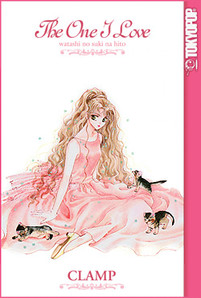Review
by Mikhail Koulikov,The One I Love
| Synopsis: |  |
||
Love is a complicated subject, and the eternal subject. The One I Love is a one-volume collection of manga "short stories" drawn by Tsubaki (Mick) Nekoi and written by Nanase Ohkawa, each of which approaches some aspect of the challenges being in love—or in a relationship—presents to modern Japanese young women. |
|||
| Review: | |||
One of the most common ways of contrasting manga with American comics has to do with story lengths. Comics, the argument goes, feature self-contained stories that are neatly resolved in thirty-two pages; the storylines in manga develop slowly through ten, twenty or more volumes. Sure enough, such a definition of manga is generally true. But, as can be expected, it is not absolute. And because it isn't absolute, any time a manga comes along that doesn't fit into the common mold, it is worth at least a look. The One I Love is unusual on at least three levels. First, it is an anthology, a slim collection of twelve "essays" with simple one-word titles like Different, Insecure and Suddenly. The essays, originally published in 1993 and compiled into a collection a year and a half later, each deal with some aspect of love and relationships. Second, it represents one of the very few instances of color in manga, even if only one of the twelve stories is colored and the rest stick to the usual black-and-white. Finally, whereas until recently, much of the CLAMP manga available in the US, such as X/1999, Magic Knight Rayearth and Card Captor Sakura featured the art of Nanase Ohkawa. The One I Love (like From a purely technical standpoint, if looked at as an exercise in visual storytelling under very restricting conditions, this is an extremely interesting work. The task that needs to be accomplished is simple: tell a complete story in no more than seven pages. Of course, manga as a visual medium is uniquely suited to accomplishing such a task, since within those seven pages, there are no limits on panel number, shape, or layout. Some pages feature a simple and straight-forward layout of rectangular panels—but there are plenty of others where the layouts are much more dynamic, almost cinematic. Frequently, the simple layout collapses entirely into complicated arrangements of text, word balloons and images. Likewise—although this is more in line with CLAMP's previous works—the art very often changes rapidly from being more or less realistic (generally to illustrate what is actually happening) to a significantly more "cute" style (chibi characters and in particular, cat ears and tails) when depicting characters' thoughts and perceptions…and then, within another panel or two, jumps back to relative realism. The One I Love is not quite as experimental in terms of layout and page design as Clover, but nonetheless, it is definitely unusual. Of course, the artwork of any given manga is only one half of the overall package. The very cover of this manga, with its image of a young woman in a pastel-colored dress playing with three kittens—sets the tone for what is beyond the cover. The twelve stories are each either utterly adorable… or painfully naïve; whether they are the one or the other depends entirely on your ability to deal with "fluffy" shoujo. No magical girls here, no cute talking animal sidekicks, no knights in shining armor. The common theme to the twelve is insecurity and self-doubt. Of a girl picking out her outfit before a date, of a girl worrying about the challenges and difficulties of being several years older than her guy, of a young woman considering her upcoming wedding and the way her relationship with her boyfriend will change once they are married. Because of the limitation imposed by having to deal with only seven pages to tell each story, the characters are never really fleshed out: they are essentially just their issues. On the other hand, the characters, at least the women who are at the center of each story, are remarkably different. They range from schoolgirls to professionals, each with a unique look and style. Ultimately, The One I Love is a minor work, and one that epitomizes the expression "your mileage may vary." Many readers will find it charming, not necessarily funny or memorable, but an enjoyable read nonetheless, but there are plenty of others for whom it will hold no interest whatsoever. In fact, I can see some female (and male) readers being angry with it precisely because it presents a view of women whose only real defining trait is worrying about the relationships they are in. Regardless, it is a fitting reminder that regardless of what is up on the shelves at the local bookstore or comic shop, manga is always much more than just fantasy or science fiction. |
|
The views and opinions expressed in this article are solely those of the author(s) and do not necessarily represent the views of Anime News Network, its employees, owners, or sponsors.
|
| Grade: | |||
|
Story : C
Art : A-
+ Unusual short story format, excellent use of layouts, one of the few slice-of-life manga currently available in English |
|||
| Production Info: | ||
|
Full encyclopedia details about Release information about |
||